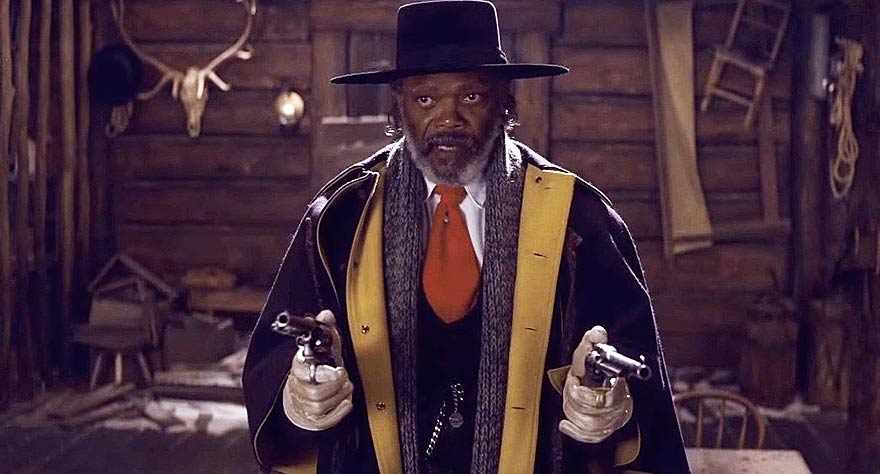
Tarantino's darkest feature provides a vulgar sense of optimism underneath its unflinching cruelty.

Tarantino's darkest feature provides a vulgar sense of optimism underneath its unflinching cruelty.
Quentin Tarantino’s last few films have crept closer to cinema’s theatrical roots. Sequences occur in contained rooms, recalling the claustrophobic, object-driven narrative environment established by the physicality of the stage. These scenes are dominated not only by the director’s trademark dialogue but also by an assured language of compositional details, which guide our eyes through the frame and divulge information with a meticulous sense of craft. Tarantino’s detractors are bothered by his compulsion to bloat his works with references to cinema’s long, colorful history, as well as an occasional penchant for comically distorting his vested tone. But after recently having the opportunity to re-watch Inglourious Basterds, it became clear that the work overall was more significant than the handful of lame gestures that prevented me from outright embracing it. A filmmaker calling attention to himself is often irritating, especially when he uses dialogue to inject his own opinion of what he’s created. But this isn’t, and shouldn’t be, anything but an unfortunate stumble along a journey that’s far more complex and rewarding than the singling-out of that gesture would imply.
The Hateful Eight is Tarantino’s most confined feature yet, which initially calls into question his use of the 70mm format. Upon first blush, the decision registers as an arbitrary homage to the golden age of American Westerns. While it is that to some degree, it’s also a method to capture minuscule details in the expressions and appearances of each duplicitous character.
The film begins in the early stages of a Wyoming blizzard as John Ruth “The Hangman” (Kurt Russell, channeling The Duke) nears the end of a journey to collect his reward, Daisy Domergue (Jennifer Jason Leigh). Along the way, they encounter two stranded individuals who Ruth reluctantly adopts as passengers. The first man is the clever and cruel Major Marquis Warren (Samuel L. Jackson), a bounty hunter we learn fought in the union army during the Civil War and the closest thing the film has to a lead character. The second scoundrel to be happened upon is Chris Mannix (a viscerally animated Walton Goggins), who identifies himself as the newly appointed sheriff in the town of Red Rock, where the entire ensemble is headed.
The four arrive at Minnie’s Haberdashery, a cramped, one-room lodge where they meet the remaining faces that make up the titular hateful eight. Bruce Dern’s Sanford Smithers was a Confederate general during the war. He has made the trek to Wyoming in the twilight hour of his life hoping to learn how his son was killed. John Gage (Michael Madsen), is a reserved, weathered cowboy who is almost certainly hiding something. Oswaldo Mobray (Tim Roth, chewing scenery in the best possible way) is a sly Englishman who claims to be Red Rock’s new hangman. Last but not least is Bob (Demián Bichir), the suspiciously gauche steward purporting himself as an employee of Minnie, thus the caretaker of the haberdashery in her absence.
It’s easy to argue that the narrative in which characters trapped in an inescapable setting are driven to face one another has been cinematically exhausted in decades prior. But Tarantino’s perspective on popular hatreds harbored throughout American history is strangely essential and unpacked with a necessary dose of self-awareness. He illustrates the tight-knit relationship between prejudice and contempt by procuring a tonal delirium punctuated by comic terror. Underneath lines of dialogue, which are programmed to register as humorous, lie disturbing implications about who our characters are and what they represent. At first, animosity is personified only through verbal slander. When tensions begin to rise, Mobray decides to split the room in half, sending Confederate sympathizers to one corner and supporters of the Union to the other. Later on, as viewers familiar with the sensibilities of Tarantino would predict, this animosity is emulated through the graphic mutilation of flesh. The segregation, however, isn’t the first instance in which folly manifests itself physically.
A percentage of those who see The Hateful Eight will be crushed by the weight of unflinching cruelty that man is capable of. But the film, circumventing all expectations, has the audacity to end on a note of coarsely drawn optimism. We’re shown the worst sensibilities of the soul through bloodied eyes, and as the tumult begins to dissipate, it becomes clear that someone’s hatred eventually had to be compromised. In a sea of gore with no redemption in sight, a subconscious shift in mindset embodies what is perhaps the most vulgar step toward progress ever captured on film.